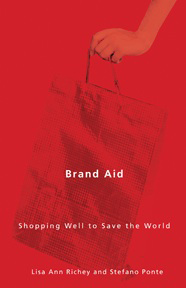Remember back in February when World Vision’s proud announcement that they were sending abroad 100,000 Super Bowl champion T-shirts emblazoned with the name of the losing team, as they have for the last 15 years, provoked aid blogger ire? We’ve been following the controversy—and occasionally piling on joining in—and here’s the latest.
In an email to Aid Watch, World Vision disclosed that total transport and administrative cost per T-shirt was 58 cents, which is uncomfortably high relative to low market values (a quick spot check produces estimates ranging from 20 cents to $1.20 for a T-shirt) in Africa's saturated second-hand clothing markets.

World Vision also sent us documents from two districts in central in Uganda* that received donated clothing, although NOT specifically the loser Super Bowl T-shirts that started this whole controversy. We learned that the donated clothing was used as part of World Vision’s health programs which aim to “improve access to better health services, safe water and sanitation.” Specifically, World Vision said:
Provision of clothing was done for women and children in extremely poor conditions to protect them from weather and to raise their self-esteem. Providing clothing also served to increase trust among the beneficiaries and encourage them to participate in other health services, including voluntary counseling and testing for HIV.
This led us to focus on the health and HIV/AIDS sections as we sifted through the documents for answers to two questions which arose in the debate.
First question we asked: Can World Vision show that they rigorously assess the need for gifts-in-kind in the communities where they work?
World Vision answered: Needs assessments are carried out by national offices, and the rigor of these assessments varies from office to office.
What the documents showed: World Vision sent us one program design document from the final phase of a 12-year, multi-sector program that ended in 2010, and one needs assessment from a neighboring region (WV couldn’t find the needs assessment for the 12-year project).
The needs assessment identified the most important problems faced by the community, and made recommendations how WV should deal with them. It did not discuss at any point the clothing needs of villagers, or how clothing donations might alleviate any of the problems mentioned in the 67-page report.
The program design documents, intended to “point out gaps that still exist in the community as expressed by the people,” made only one mention of gifts-in-kind. “Gifts in kind will be planned for on annual basis and this is meant to supplement the project fund in achieving project planned activities.”
The main report did not mention a need for clothing. However, I did learn that the region described is among those most heartbreakingly affected by HIV/AIDS, with high numbers of orphans and child-headed households, and after some digging I found an HIV/AIDS sub-report embedded within the main report that did mention clothing:
Most of these [orphaned children] lack care and support in terms of emotional coping, physical requirements like food, shelter, clothing, and limited access to basic social services like education and health.
Another embedded sub-report (actually a proposal for outside funding to support HIV/AIDS orphans in the area) was more specific:
Special needs will be identified for each of the selected families and the project will organize to procure and provide the essential needs for the children and guardians. These will include beddings, bicycles, clothing, cooking pans, washing basins and water tanks.
Our conclusion on the first question: No.
Second question we asked: Can WV point to any evidence that the 15-year distribution of Super Bowl T-shirts, or, more broadly, any distribution of clothing, has "facilitate[d] good, sustainable development"?
World Vision answered: No, “because the Superbowl clothing isn’t a program. It’s a donation. We evaluate the results of our programs…many of the programs where we use GIK have been enormously successful in facilitating good, sustainable development. Our evidence for that would be individual program evaluations from a variety of national offices.”
What the documents showed: WV sent us one annual report and program evaluations for each phase of the same 12-year project discussed above. After hours of reading, a picture emerged of a community decimated by the HIV/AIDS epidemic and valiantly struggling to provide support for the large populations of vulnerable children made orphans or adopted into already over-stretched extended families.
An annual report from 2006 gave the only specific accounting of the type of gifts-in-kind distributed:
GIK was received and distributed to children and these included 115 pairs of canvas shoes, 50 pairs of baby shoes, 900 T- shirts, 225 Gin trousers, 500 pairs of socks, 125 dolls and 200 blankets. This benefited 1615 children in the community.
In a report from the first phase of the project, evaluators noted that some villagers were able to sell eggs from a poultry project to buy clothes (this shows that clothing is available for purchase in the community, and probably not at prohibitive prices for most people). Clothing was also mentioned as an obstacle to achieving the program’s “Christian Witness” objective: the poor don’t attend church because “they lack good cloth to put on and feel not worth attending.”
Regarding World Vision’s ability to show success in facilitating sustainable development through their programming in general, the 2006 evaluation said “tracking changes…attributable to World Vision support” is “quite difficult” because over the course of the 12-year project priorities and goals shifted, and because early baseline measurements don’t match up with later evaluations.
Nonetheless, the final report attributed many positive health outcomes to project activities. For example, reduced malaria incidence; improved sanitation practices; and reduced prevalence of HIV/AIDS.
We don’t see any basis for attribution of these outcomes to World Vision, since the program was not designed in such a way to make such attribution possible. The resources provided by World Vision—clinics built, medicines supplied, HIV awareness courses given—are characterized as improving health outcomes, but also as very thinly spread over a large area with acute health needs.
As to sustaining project gains as WV funding ends, WV reported that local organizations have been trained in skills like proposal writing, resource mobilization and networking so that they can take over WV services. Villagers in the final survey said they learned “vocational, business management, leaderships, improved farming, HIV/AIDS care, positive parenting, and sanitation management skills,” all of which would provide a “pillar to further development in this area.”
Our conclusion on the second question: While we appreciate WV’s transparency in sharing these documents with Aid Watch, we have to conclude that the answer is no. There is no real evidence in these hundreds of pages of reports that the clothing donations are more than a minor afterthought to World’s Vision’s health programming (although gifts-in-kind are a major source of World Vision’s revenue). Given the aforementioned costs required to ship donations from the US abroad there is no development-related reason to continue this outdated, dependency-creating practice.
*World Vision asked us not to publish the names of the regions, or any other identifying information about the projects.
--
Related posts:
In Zambia, Pittsburgh won the Super Bowl: Why is World Vision perpetuating discredited T-shirt aid?
World Vision responds to blogger questions
 From Aid to Equality
From Aid to Equality







